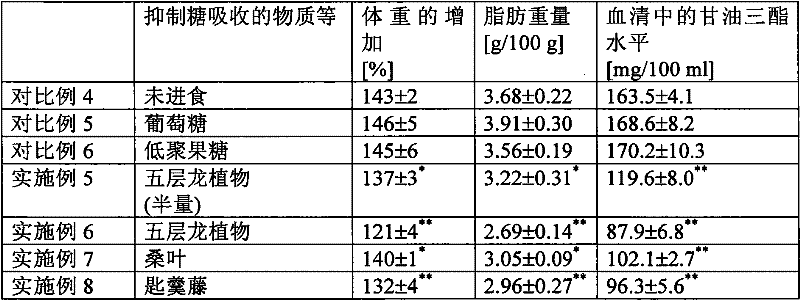Agent for regulating composition ratio of intestinal bacterial flora
A technology of intestinal bacteria and regulators, applied in the direction of plant/algae/fungus/moss ingredients, food ingredients, organic active ingredients, etc., can solve the problems of burden, no proliferation of Bacteroides bacteria, reduction, etc., and achieve no side effects , improve the immune index, reduce the effect of allergic symptoms
- Summary
- Abstract
- Description
- Claims
- Application Information
AI Technical Summary
Problems solved by technology
Method used
Image
Examples
test approach 1
[0035] Sucrase IC 50 Determination of value
[0036] Preparation of sample solution: 2 mg of a sample (substance that inhibits α-glucosidase activity) was weighed into a test tube, and 2 mL of water was added thereto, and then the sample was completely suspended to form a sample solution having a concentration of 1 mg / mL. It was diluted with water to form solutions at 0, 50, 100, 250 and 500 μg / mL, respectively.
[0037] Preparation of substrate solution: Sucrose was dissolved in 0.2M maleate buffer (pH 6.0) so that the sucrose concentration was 100 mM, and the solution was used as a substrate solution.
[0038] Preparation of crude enzyme solution: After suspending 1 g of rat intestinal acetone powder rat (manufactured by SIGMA) in 10 mL of physiological saline, the suspension was centrifuged (3000 rpm, 4° C., 5 min). The resulting supernatant was separated and used as crude enzyme solution.
[0039] To 500 μL of the above sample solutions having respective concentrations ...
Embodiment
[0099] The present invention will be described below with reference to examples, but the present invention is not limited to the following examples.
[0100] After pulverizing the root and stem parts of Salacia reticulata and Salacia oblongatus, they were mixed in equal weight, and the liquid obtained through the hot water extraction step at 98°C was spray-dried to obtain Salacia extract powder1. Salacia extract powder 1 has a sucrase IC50 value of 41 (μg / ml).
[0101] In addition, for Gymnema and mulberry leaf extracts, those available from K.K. Cross can be used.
[0102] Also, for the comparative example, glucose, lard, and oolong tea polymerized polyphenols (obtained by freeze-drying black oolong tea produced by Suntory Ltd. and extracting oolong tea polymerized polyphenols) were used. In addition, for Gymnema, mulberry leaf extract, glucose, lard, and oolong tea polyphenols, their sucrase 50% inhibitory concentrations (IC 50 value) of 800 μg / mL or greater.
[0103] Th...
experiment example 1
[0105] Eight-week-old male SD rats were divided into seven rat groups. Each of the following intestinal bacterial flora composition ratio regulators was dissolved in water for injection, and ingested over a week in an amount equivalent to 20 mg / kg / day using a gastric feeding tube (stomach sonde). The ratio of bacteria of the genus Bacteroidetes and Firmicutes to the intestinal bacterial community was determined by the T-RFLP method (Nagashima method) immediately before and immediately after ingestion, respectively. However, in Example 1 half the amount (10 mg / kg / day) of intestinal bacterial flora constituted the ratio regulator was used.
[0106] Table 1 shows the proportions of bacteria belonging to the genus Bacteroides and Firmicutes relative to the intestinal bacterial flora (the proportion obtained when the total number of bacteria is taken as 100%).
[0107]
[0108] As for the results of this experimental example, it shows that the substance that inhibits sugar abso...
PUM
 Login to View More
Login to View More Abstract
Description
Claims
Application Information
 Login to View More
Login to View More - R&D
- Intellectual Property
- Life Sciences
- Materials
- Tech Scout
- Unparalleled Data Quality
- Higher Quality Content
- 60% Fewer Hallucinations
Browse by: Latest US Patents, China's latest patents, Technical Efficacy Thesaurus, Application Domain, Technology Topic, Popular Technical Reports.
© 2025 PatSnap. All rights reserved.Legal|Privacy policy|Modern Slavery Act Transparency Statement|Sitemap|About US| Contact US: help@patsnap.com


